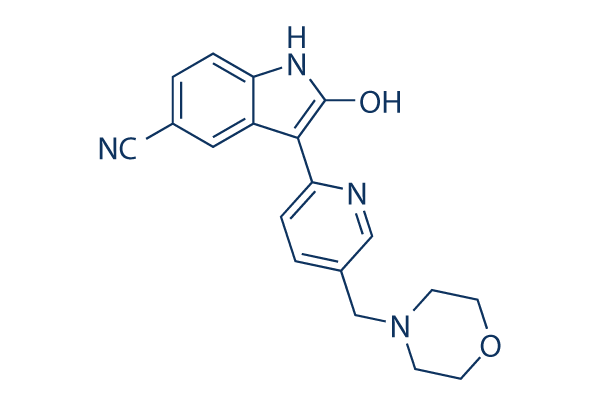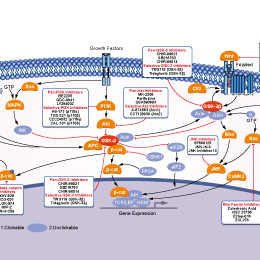
- Bioactive Compounds
- By Signaling Pathways
- PI3K/Akt/mTOR
- Epigenetics
- Methylation
- Immunology & Inflammation
- Protein Tyrosine Kinase
- Angiogenesis
- Apoptosis
- Autophagy
- ER stress & UPR
- JAK/STAT
- MAPK
- Cytoskeletal Signaling
- Cell Cycle
- TGF-beta/Smad
- DNA Damage/DNA Repair
- Compound Libraries
- Popular Compound Libraries
- Customize Library
- Clinical and FDA-approved Related
- Bioactive Compound Libraries
- Inhibitor Related
- Natural Product Related
- Metabolism Related
- Cell Death Related
- By Signaling Pathway
- By Disease
- Anti-infection and Antiviral Related
- Neuronal and Immunology Related
- Fragment and Covalent Related
- FDA-approved Drug Library
- FDA-approved & Passed Phase I Drug Library
- Preclinical/Clinical Compound Library
- Bioactive Compound Library-I
- Bioactive Compound Library-Ⅱ
- Kinase Inhibitor Library
- Express-Pick Library
- Natural Product Library
- Human Endogenous Metabolite Compound Library
- Alkaloid Compound LibraryNew
- Angiogenesis Related compound Library
- Anti-Aging Compound Library
- Anti-alzheimer Disease Compound Library
- Antibiotics compound Library
- Anti-cancer Compound Library
- Anti-cancer Compound Library-Ⅱ
- Anti-cancer Metabolism Compound Library
- Anti-Cardiovascular Disease Compound Library
- Anti-diabetic Compound Library
- Anti-infection Compound Library
- Antioxidant Compound Library
- Anti-parasitic Compound Library
- Antiviral Compound Library
- Apoptosis Compound Library
- Autophagy Compound Library
- Calcium Channel Blocker LibraryNew
- Cambridge Cancer Compound Library
- Carbohydrate Metabolism Compound LibraryNew
- Cell Cycle compound library
- CNS-Penetrant Compound Library
- Covalent Inhibitor Library
- Cytokine Inhibitor LibraryNew
- Cytoskeletal Signaling Pathway Compound Library
- DNA Damage/DNA Repair compound Library
- Drug-like Compound Library
- Endoplasmic Reticulum Stress Compound Library
- Epigenetics Compound Library
- Exosome Secretion Related Compound LibraryNew
- FDA-approved Anticancer Drug LibraryNew
- Ferroptosis Compound Library
- Flavonoid Compound Library
- Fragment Library
- Glutamine Metabolism Compound Library
- Glycolysis Compound Library
- GPCR Compound Library
- Gut Microbial Metabolite Library
- HIF-1 Signaling Pathway Compound Library
- Highly Selective Inhibitor Library
- Histone modification compound library
- HTS Library for Drug Discovery
- Human Hormone Related Compound LibraryNew
- Human Transcription Factor Compound LibraryNew
- Immunology/Inflammation Compound Library
- Inhibitor Library
- Ion Channel Ligand Library
- JAK/STAT compound library
- Lipid Metabolism Compound LibraryNew
- Macrocyclic Compound Library
- MAPK Inhibitor Library
- Medicine Food Homology Compound Library
- Metabolism Compound Library
- Methylation Compound Library
- Mouse Metabolite Compound LibraryNew
- Natural Organic Compound Library
- Neuronal Signaling Compound Library
- NF-κB Signaling Compound Library
- Nucleoside Analogue Library
- Obesity Compound Library
- Oxidative Stress Compound LibraryNew
- Plant Extract Library
- Phenotypic Screening Library
- PI3K/Akt Inhibitor Library
- Protease Inhibitor Library
- Protein-protein Interaction Inhibitor Library
- Pyroptosis Compound Library
- Small Molecule Immuno-Oncology Compound Library
- Mitochondria-Targeted Compound LibraryNew
- Stem Cell Differentiation Compound LibraryNew
- Stem Cell Signaling Compound Library
- Natural Phenol Compound LibraryNew
- Natural Terpenoid Compound LibraryNew
- TGF-beta/Smad compound library
- Traditional Chinese Medicine Library
- Tyrosine Kinase Inhibitor Library
- Ubiquitination Compound Library
-
Cherry Picking
You can personalize your library with chemicals from within Selleck's inventory. Build the right library for your research endeavors by choosing from compounds in all of our available libraries.
Please contact us at info@selleckchem.com to customize your library.
You could select:
- Antibodies
- Bioreagents
- qPCR
- 2x SYBR Green qPCR Master Mix
- 2x SYBR Green qPCR Master Mix(Low ROX)
- 2x SYBR Green qPCR Master Mix(High ROX)
- Protein Assay
- Protein A/G Magnetic Beads for IP
- Anti-Flag magnetic beads
- Anti-Flag Affinity Gel
- Anti-Myc magnetic beads
- Anti-HA magnetic beads
- Poly DYKDDDDK Tag Peptide lyophilized powder
- Protease Inhibitor Cocktail
- Protease Inhibitor Cocktail (EDTA-Free, 100X in DMSO)
- Phosphatase Inhibitor Cocktail (2 Tubes, 100X)
- Cell Biology
- Cell Counting Kit-8 (CCK-8)
- Animal Experiment
- Mouse Direct PCR Kit (For Genotyping)
- New Products
- Contact Us
AZD1080
GSK-3 inhibitor
research use only
AZD1080 is a selective, orally active, brain permeable GSK3 inhibitor, inhibits human GSK3α and GSK3β with Ki of 6.9 nM and 31 nM, respectively, shows >14-fold selectivity against CDK2, CDK5, CDK1 and Erk2.

AZD1080 Chemical Structure
Molecular Weight: 334.37
Purity & Quality Control
Batch:
Purity:
99.97%
99.97
AZD1080 Related Products
| Related Targets | GSK-3α GSK-3β | Click to Expand |
|---|---|---|
| Related Products | Laduviglusib (CHIR-99021) Laduviglusib (CHIR-99021) monohydrochloride SB216763 TWS119 CHIR-98014 BIO LY2090314 Tideglusib SB415286 AR-A014418 1-Azakenpaullone IM-12 CP21R7 TDZD-8 Indirubin (NSC 105327) AZD2858 BIO-acetoxime Bikinin | Click to Expand |
| Related Compound Libraries | Kinase Inhibitor Library PI3K/Akt Inhibitor Library Apoptosis Compound Library Cell Cycle compound library NF-κB Signaling Compound Library | Click to Expand |
Signaling Pathway
Mechanism of Action
| Description | AZD1080 is a selective, orally active, brain permeable GSK3 inhibitor, inhibits human GSK3α and GSK3β with Ki of 6.9 nM and 31 nM, respectively, shows >14-fold selectivity against CDK2, CDK5, CDK1 and Erk2. | ||||
|---|---|---|---|---|---|
| Features | A brain permeable GSK3 inhibitor. | ||||
| Targets |
|
In vitro |
||||
| In vitro | AZD1080 is a selective, orally active, brain permeable GSK3 inhibitor, inhibits human GSK3α and GSK3β with a Ki of 6.9 nM and 31 nM, respectively, shows >14-fold selectivity against cdk2, cdk5, cdk1 and Erk2. AZD1080 inhibits tau phosphorylation in cells expressing human tau, with IC50 of 324 nM. [1] |
|||
|---|---|---|---|---|
| Kinase Assay | Kinase Assay | |||
| GSK3 scintillation proximity assay is done. The competition experiments are carried out in duplicate with 10 concentrations of the inhibitor in clear-bottomed microtiter plates. The biotinylated peptide substrate biotin-AAEELDSRAGS(PO3H2)PQL, is added at a final concentration of 2 μM in an assay buffer containing 6 milliunits of recombinant human GSK3 (equal mix of both α and β), 12 mM MOPS, pH 7.0, 0.3 mM EDTA, 0.01% β-mercaptoethanol, 0.004% Brij 35, 0.5% glycerol, and 0.5 μg of bovine serum albumin/25 μl and preincubated for 10–15 min. The reaction is initiated by the addition of 0.04 μCi of [γ-33P]ATP and unlabeled ATP in 50 mM Mg(Ac)2 to a final concentration of 1 μM ATP and assay volume of 25 μl. Blank controls without peptide substrate are used. After incubation for 20 min at room temperature, each reaction is terminated by the addition of 25 μl of stop solution containing 5 mM EDTA, 50 μM ATP, 0.1% Triton X-100, and 0.25 mg of streptavidin-coated SPA beads corresponding to 35 pmol of binding capacity. After 6 h the radioactivity is determined in a liquid scintillation counter. | ||||
| Cell Research | Cell lines | 3T3 fibroblasts stably expressing 4-repeat human tau | ||
| Concentrations | ~20mM | |||
| Incubation Time | 0-8 h | |||
| Method | 3T3 fibroblasts are engineered to stably express four-repeat tau protein. These cells have high endogenous levels of GSK3 that is able to phosphorylate tau protein constitutively. This phosphorylation is inhibited by LiCl. After treatment with different compounds, cultures are washed twice with 5 mM MgCl2-PBS. The samples are homogenized at 4 °C, and protein content is determined by Bradford method. Total protein (25 μg) is electrophoresed on 10% SDS-PAGE gel and transferred to a nitrocellulose membrane. The experiments are performed using the following primary antibodies: tau Ser(P)-396, 1:1000; Tau5, 1:1000; and anti-GSK3β, 1:1000. The filters are incubated with the antibody at 4 °C overnight in 5% nonfat dried milk. A secondary antibody (1:5000), followed by ECL detection reagents are used for immunodetection. Quantitation of immunoreactivity is performed by densitometric scanning. |
|||
In Vivo |
||
| In vivo | AZD1080 inhibits tau phosphorylation in rat brain after oral dministration, with brain/plasma exposure ratio of 0.5 – 0.8 at peak concentrations. AZD1080 reverses cognitive deficits and rescues dysfunctional synapses in mice. Acute oral treatment with AZD1080 inhibits peripheral GSK3 activity, produces a dose-dependent reduction of the phosphorylated to total glycogen synthase (GS) ratio, with a mean maximal inhibitory effect of 49% at the highest dose (10 μmol/kg) at 2 h after dosing. [1] |
|
|---|---|---|
| Animal Research | Animal Models | C57BL/6 mice |
| Dosages | 3 or 10 μmol/kg, 6 mL/kg | |
| Administration | oral gavage | |
References |
|
Chemical Information
| Molecular Weight | 334.37 | Formula | C19H18N4O2 |
| CAS No. | 612487-72-6 | SDF | Download AZD1080 SDF |
| Synonyms | N/A | ||
| Smiles | C1COCCN1CC2=CN=C(C=C2)C3=C(NC4=C3C=C(C=C4)C#N)O | ||
Storage and Stability
| Storage (From the date of receipt) | |||
|
In vitro |
DMSO : 52 mg/mL ( (155.51 mM) Moisture-absorbing DMSO reduces solubility. Please use fresh DMSO.) Water : Insoluble Ethanol : Insoluble |
Molecular Weight Calculator |
|
In vivo Add solvents to the product individually and in order. |
In vivo Formulation Calculator |
|||||
Preparing Stock Solutions
Molarity Calculator
In vivo Formulation Calculator (Clear solution)
Step 1: Enter information below (Recommended: An additional animal making an allowance for loss during the experiment)
mg/kg
g
μL
Step 2: Enter the in vivo formulation (This is only the calculator, not formulation. Please contact us first if there is no in vivo formulation at the solubility Section.)
% DMSO
%
% Tween 80
% ddH2O
%DMSO
%
Calculation results:
Working concentration: mg/ml;
Method for preparing DMSO master liquid: mg drug pre-dissolved in μL DMSO ( Master liquid concentration mg/mL, Please contact us first if the concentration exceeds the DMSO solubility of the batch of drug. )
Method for preparing in vivo formulation: Take μL DMSO master liquid, next addμL PEG300, mix and clarify, next addμL Tween 80, mix and clarify, next add μL ddH2O, mix and clarify.
Method for preparing in vivo formulation: Take μL DMSO master liquid, next add μL Corn oil, mix and clarify.
Note: 1. Please make sure the liquid is clear before adding the next solvent.
2. Be sure to add the solvent(s) in order. You must ensure that the solution obtained, in the previous addition, is a clear solution before proceeding to add the next solvent. Physical methods such
as vortex, ultrasound or hot water bath can be used to aid dissolving.
Tech Support
Answers to questions you may have can be found in the inhibitor handling instructions. Topics include how to prepare stock solutions, how to store inhibitors, and issues that need special attention for cell-based assays and animal experiments.
Tel: +1-832-582-8158 Ext:3
If you have any other enquiries, please leave a message.
* Indicates a Required Field






































